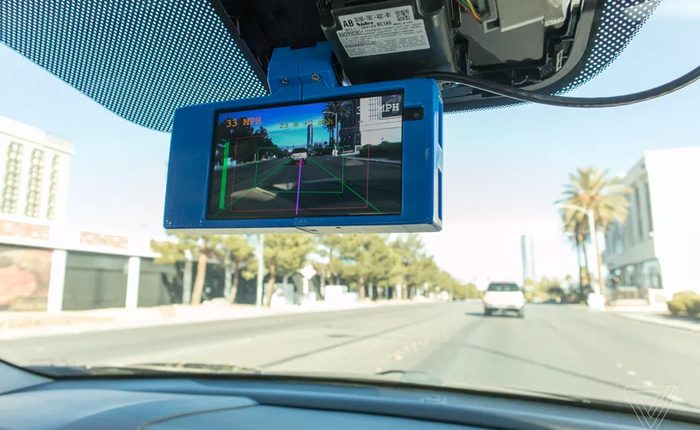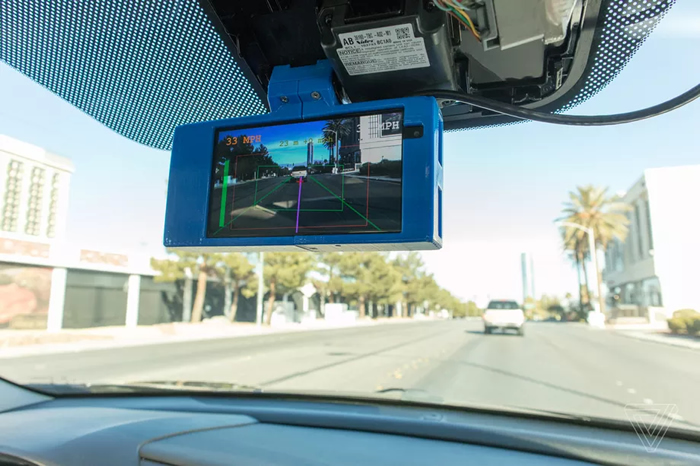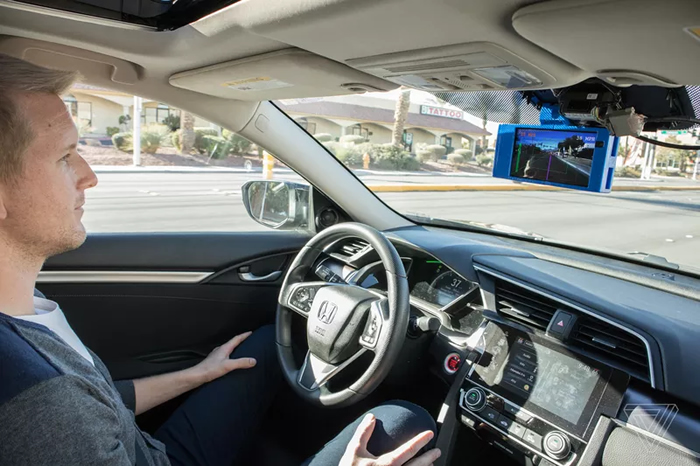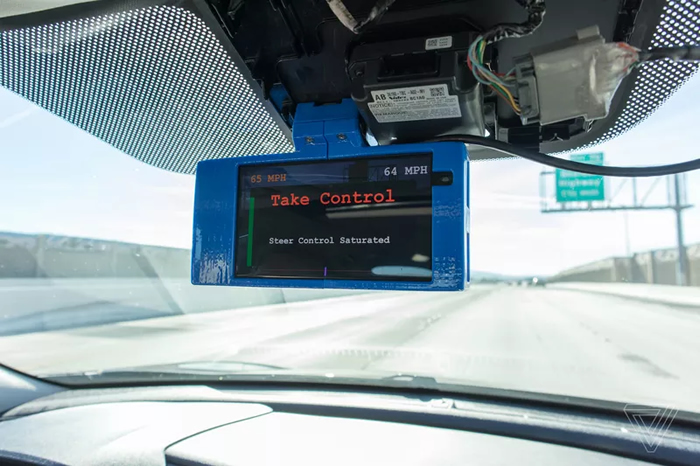Rearview mirror replacement makes your car semi-autonomous
iPhone and PlayStation 3 hacker George Hotz teased a project that sounded like a dream in late 2015: his new company would produce a $1,000 consumer product that could grant your car semi-autonomous capabilities. Eleven months and one terse letter from the National Highway Traffic Safety Administration later, Hotz killed the project.
About a month after that, Hotz resurrected it as a two open-source efforts, splitting the hardware and software of the self-driving tech he had created with the rest of his company, Comma.ai. Hotz always talked like he wanted to start a DIY car revolution to take on the car industry (and Elon Musk especially). Open sourcing the plans only increased the chances of it happening.
Now, just weeks after releasing those plans on GitHub, the first spin on Hotz’s hardware is out. A small company called Neodriven, led by former Tesla employee Matt Schulwitz, is announcing a product of the same name that goes on sale today for $1,495. It’s a modified version of the Comma Neo plans that Hotz open sourced, but if Schulwitz has his way, it will be an early player in that revolution.
Schulwitz brought a prototype of Neodriven’s hardware (and a compatible Honda Civic) to Las Vegas last week during the Consumer Electronics Show. It’s rudimentary at the moment — a blue 3D-printed case holds the OnePlus 3 phone, circuit board, and other components together. But it was finished enough to imbue his car with Comma.ai’s self-driving software during a one-hour demo around the Las Vegas streets and highways.
Schulwitz says he and his brother acted immediately when Hotz made the open-source announcement. “We started sourcing parts and working with different suppliers literally within 24 hours of the news breaking,” Schulwitz says. The two brought in a few friends with engineering chops, and together they worked straight through the holidays. They hand-soldered the circuit board, 3D-printed the case, and loaded up Comma’s Open Pilot self-driving software.
That might make Neodriven’s idea sound like one that’s only for tinkerers, but part of Schulwitz’s pitch for the Neodriven hardware is the simple installation. All a prospective buyer would have to do is pop off the plastic that hides the Honda Civic’s or the Acura ILX’s driver assistance camera on the windshield, plug the Neodriven hardware into the available port via an Ethernet adapter, and slide it into place using the existing mount.
Schulwitz says the first few attempts with Open Pilot were not very nerve-wracking, and compared them to the rollout and early versions of Tesla’s Autopilot — a comparison that Hotz has made a number of times.
What that meant on the road is that, without human intervention, the Civic could match the speed of cars in front of us or slow to a stop behind them at a light. The car also kept itself within the lanes on the streets and highways, an impressive feat considering the roads of Las Vegas are mostly marked with dots and not painted lines.
The car even managed a few tight turns, and at one point likely prevented an accident by applying the brakes when we came up too fast on a traffic-clogged right-turn-only lane on the highway. It wasn’t perfect, though — the car drifted out of lanes on three occasions when Open Pilot was engaged, and one time it even forced us to take an unwanted exit as a result.
None of these experiences were much different from our initial experience with Comma’s self-driving software last summer. There are many limitations, too. Open Pilot can’t stop at red lights — it needs a car in front of it to slow down for that to happen — and it can’t make turns. It also doesn’t have a full 360-degree view, so you have to be very aware of what’s beside and behind you.
Open Pilot is also in desperate need of better alert noises — the same ping sounds whether you’re taking control back from the software and when the system tries to tell you that it’s no longer capable of managing the roads. And overall, the system tends to struggle when the lighting changes abruptly.
Of course, Neodriven doesn’t require you to use Open Pilot, though users would be at the mercy of the market and would have to wait for compatible alternatives. (As for the legality, mirror regulations can differ state to state. “Everyone who purchases this should obey local laws,” Schulwitz says.)
What’s impressive about Neodriven is that Schulwitz and his team were able to conjure up hardware capable of making something approaching autonomoy in just one month. And while my demo was all about showing off the product’s ability to control your car, Schulwitz repeatedly clarified that Neodriven isn’t associated with Comma.ai or Hotz, and that the relationship ends at the plans that were exchanged on GitHub.
“What we’ve built is not any sort of self-driving car, it’s not autonomous, it’s not semi-autonomous, and when it ships to customers it will actually have absolutely no preinstalled software,” Schulwitz said. “It’s just simply a very powerful computer that can mount in your car. And so the way we think about it right now, it’s not just necessarily something that can be compatible with Comma.ai’s open pilot. It’s a whole new platform for open source developers to develop all types of different apps.”
What would be different about Neodriven’s approach is that these apps would operate out of the control of the car companies, and in some ways offer the customer options beyond Apple’s CarPlay and Google’s Android Auto. It also means users would have more control over the hard data generated by their cars. “It’s just a much more powerful platform than what’s offered from the OEMs, at least at this price point,” Schulwitz says. In some ways, his vision is reminiscent of the first smartphones and their respective app stores.
Neodriven is only selling the hardware, an investment that relies on developers to make it useful. If that works, it’s a fascinating and roguish idea — adding a DIY, open-source computer to your car that could enable features that go beyond the scope or wishes of the car and tech companies that are fighting to control it. It’s also one that’s likely to piss off those companies, and could wind up sparking the same NHTSA involvement that made Hotz balk on a consumer release in the first place. (Schulwitz says he’s willing to talk to and work with NHTSA should they reach out, for what it’s worth.)
Neodriven’s first orders are most likely to come from the software developers who want to build on the foundation that Hotz laid, Schulwitz says. “There’s this pent-up demand with people who have been following Comma.ai for a long time, and they’ve wanted to buy one of these things,” Schulwitz says. “This is the first chance to buy it on the open market.”
Beyond that small community of developers, it’s unclear what kind of customer would want to buy what Neodriven is selling without a more compelling suite of features. Most people are generally fine with the cars they buy, especially with the proliferation of Android Auto and Apple’s CarPlay.
But tinkering has always been a part of car culture. And with cars increasingly becoming more like gadgets, it only makes sense that some of those tinkerers will want to start playing with code. If a DIY smart car revolution happens, which is a big if, Neodriven could be looked back on as one of the first shots fired.
As for Hotz, he acknowledged that Schulwitz reached out to him and reiterated that the two parties aren’t working together. “We absolutely encourage others to start businesses around what we give away,” Hotz says. “If we are the Android of self driving cars, we need people to be the Samsung and Xiaomi. Great money making opportunity!”
More information: The Verge





Comments are closed, but trackbacks and pingbacks are open.